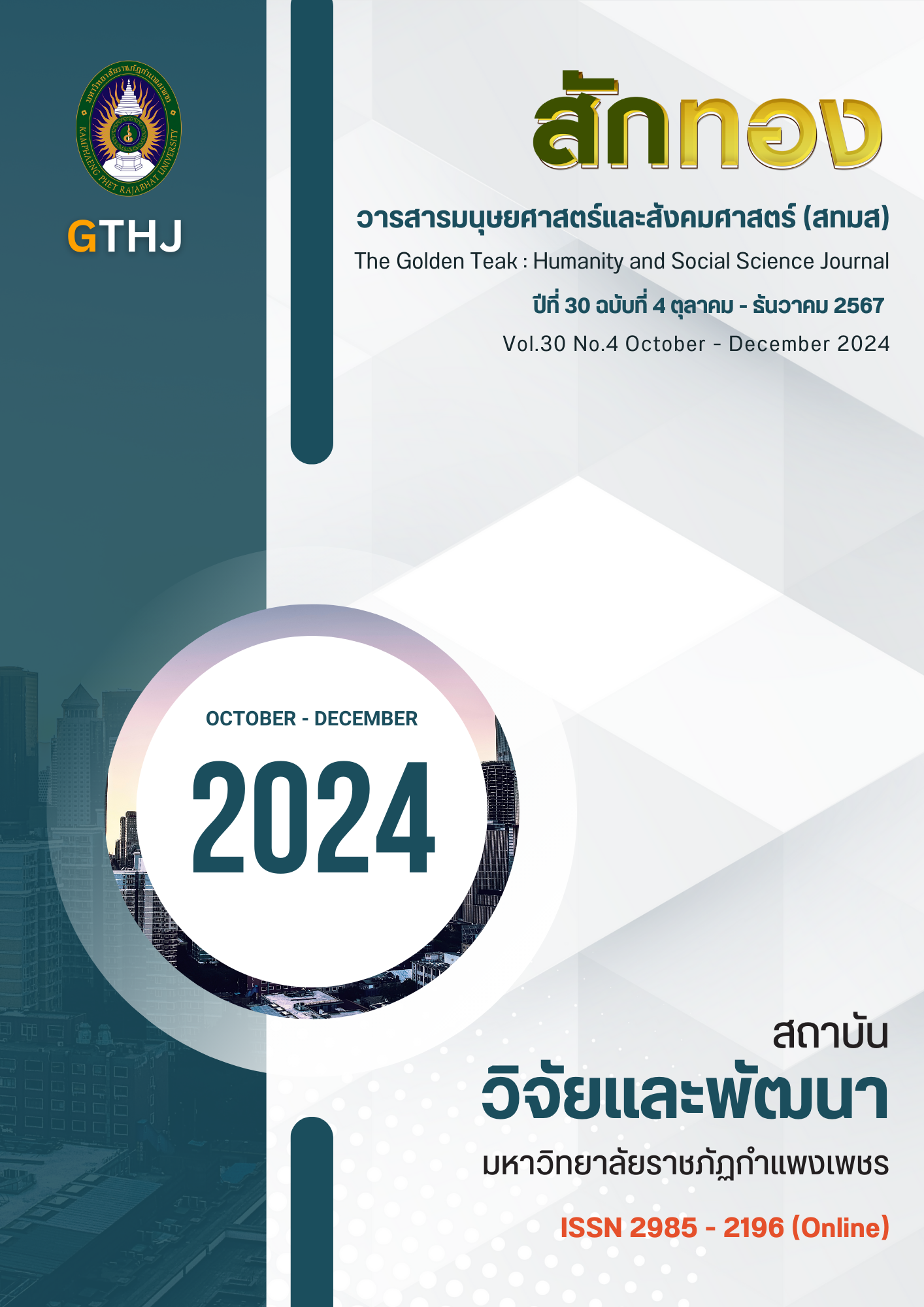A Mediation Analysis of Loyalty on the Relationship between work Life Balance and Innovative Behavior
Main Article Content
Abstract
The aim of this research was to examine how loyalty mediates the relationship between work life balance and innovative behavior. The study focused on employees working in convenience stores in Bangkok. A sample of 400 employees which were selected by accidental sampling. The instrument for data collection was questionnaires. The data were analyzed using frequency, percentage, mean and standard deviation, and testing the hypothesis by using correlation analysis and hierarchical regression analysis. The research findings can be summarized as follows: Firstly, work life balance displayed a significant positive correlation with loyalty at the .01 level. Secondly, loyalty exhibited a significant positive correlation with innovative behavior at the .01 level. Thirdly, work life balance demonstrated a significant positive correlation with innovative behavior at the .01 level. Lastly, loyalty was found to partially mediate the relationships between work life balance and innovative behavior.
Article Details

This work is licensed under a Creative Commons Attribution-NonCommercial-NoDerivatives 4.0 International License.
บทความที่ได้รับการตีพิมพ์เป็นลิขสิทธิ์ของวารสาร สักทอง : วารสารมนุษยศาสตร์และสังคมศาสตร์ สถาบันวิจัยและพัฒนา มหาวิทยาลับราชภัฏกำแพงเพชร
ข้อคิดเห็นใดๆ ที่ปรากฎในวารสารเป็นวรรณกรรมของผู้เขียนโดยเฉพาะ ซึ่งมหาวิทยาลัยราชภัฏกำแพงเพชรและบรรณาธิการไม่จำเป็นต้องเห็นด้วย
References
Awang, Z., Wan Afthanorhan, W.M.A. & Asri, M.A. (2015). Parametric and non parametric approach in structural equation modeling (SEM): The application of bootstrapping. Modern Applied Science, 9(9), 58-67.
Bagis, F. & Adawiyah, W.R. (2022). Work-Life balance and work culture on employee loyalty in construction companies:The mediating role of job satisfaction. [Online]. Available : https://eudl.eu/pdf/10.4108/eai.10-8-2022.2320908 [2022, January 5].
Baron, R.M. & Kenny, D.A. (1986). The moderator–mediator variable distinction in social psychological research: Conceptual, strategic, and statistical considerations. Journal of Personality and Social Psychology, 51(6), 1173-1182.
Buntam, P. (2016). The Relationships between Human Resource Management and Work Life Balance towards Organizational Commitment: A Case Study of Bangkok Commercial Asset Management Public Company Limited. [Online]. Available : http://www.repository.rmutt.ac.th/dspace/bitstream/123456789/2893/1/RMUTT-154361.pdf [2022, March 16]. [In Thai]
Capnary, M.C., Rachmawati, R. & Agung, I. (2018). The influence of flexibility of work to loyalty and employee satisfaction mediated by work life balance to employees with millennial generation background in Indonesia startup companies. Business: Theory and Practice, 19, 217-227.
CBRE. (2022). CBRE reveals convenience store trends adapting to new lifestyles. [Online]. Available : https://www.cbre.co.th/th-th/press-releases/competition-on-convenience [2023, November 9]. [In Thai]
Cloudfront. (2022). Find 7-11 branch. [Online]. Available : https://de2zkilidxgsz.cloudfront.net/ [2022, October 20]. [In Thai]
Cochis, C., Mattarelli, E., Bertolotti, F., Scapolan, A. C., Montanari, F. & Ungureanu, P. (2020). How perceptions of work-life balance and technology use impact upon creativity in collaborative spaces. [Online]. Available : https://scholarworks.sjsu.edu/cgi/viewcontent.cgi?article=1112&context=faculty_rsca [2022, March 16].
Darus, A., Mustafa Kamil, B. & Ishammudin, M. (2019). Loyalty as mediator in the relationship of leadership style and performance: an examination among commercial banks employees in klang valley, malaysia. [Online]. Available : https://www.ijeat.org/wp-content/uploads/papers/v9i1/ A2626109119.pdf [2022, January 12].
De Jong, J.P. (2007). Individual innovation: the connection between leadership and employees’ innovative work behavior. Dissertation Faculty of Economics and Business The Institutional Repository of the University of Amsterdam.
Dede, Y.E. & Sazkaya, M.K. (2018). The mediating role of employee loyalty between employee empowerment and employee innovative behavior: a study from Teknopark Istanbul. Çankırı Karatekin Üniversitesi İİBF Dergisi, 8(1), 55-82.
Eisenberger, R. & Rhoades, L. (2001). Incremental effects of reward on creativity. Journal of Personality and Social Psychology, 81, 728-741.
Hair, J.F. Jr., Hult, G.T.M., Ringle, C.M. & Sarstedt, M. (2014). A Premier on Partial Least Squares Structural Equation Modeling (PLS-SEM). Thousand Oaks, CA : SAGE Publications Ltd.
Hsiao, H., Chang, J., Tu, Y. & Chen, S. (2011). The impact of self-efficacy on innovative work behavior for teachers. International Journal of Social Science and Humanity, 1(1), 31-36.
Hui, C.H., Pak, S.T., Kwan, S.O. & Chao, A. (2012). Attributional style and engagement/disengagement responses in the Chinese workforce. Applied Psychology : An International Review, 61(2), 204-226.
Jigjiddorj, S., Tsogbadrakh, T., Choijil, E. & Zanabazar, A. (2019). The mediating effect of employee loyalty on the relationship between job satisfaction and organizational performance. [Online]. Available : https://www.atlantis-press.com/ proceedings/emt-19/125906247 [2022, January 12].
Khaopratoom, W., Duangwiset, B. & Wuthichumpoo, N. (2023). The Developmentof Creative Thinkingby Phenomenon Based Learning. The Golden Teak : Humanity and Social Science Journal, 29(1), 162-179. [In Thai]
Kumar, R. & Uzkurt, C. (2010). Investigating the effects of self efficacy on innovativeness and the moderating impact of cultural dimensions. Journal of International Business & Cultural Studies, 4(1), 1-15.
Piriyakul, M. (2015). Mediators and tests of indirect effect. Journal of management and development, Ubonratchathani Rajabhat University, 2(1), 11-30. [In Thai]
Piriyakul, M. (2021). Mediation model and Moderation model. [Online]. Available : http://www.research.ru.ac.th/ images/ArticleMr/1631880530_Article.pdf [2023, November 9]. [In Thai]
Roehling, P.V., Roehling, M.V. & Moen, P. (2001). The relationship between work-life policies and practices and employee loyalty: A life course perspective. Journal of Family and Economic, 22(2), 141-170.
Shoukun, C., Kaili, X. & Xiwen, Y. (2022). Empirical study of employee loyalty and satisfaction in mining industry using structural equation modeling. [Online]. Available : https://www.nature.com/articles/s41598 022 051822.pdf [2022, June 23].
Silpcharu, T. (2009). Research and statistical data analysis with SPSS. Bangkok : Business R&D General Partnership. [In Thai]
Sobel, M.E. (1982). Asymptotic confidence intervals for indirect effects in structural equation models. In S. Leinhardt (Ed.), Sociological Methodology 1982(pp.290-312). Washington DC : American Sociological Association.
Tunpaiboon, N. (2021). Business Industry Trends 2021–2023: Modern Retail Business. [Online]. Available : https://www.krungsri.com/th/research/industry/industryoutlook/wholesale-retail/modern-trade/io/io-modern-trade-21 [2022, March 24]. [In Thai]
Yusof, R., Imm, N.S., Ann, H.J. & Rahman, A.A. (2018). The influence of SMEs employees’ intention towards innovative behaviour. Pertanika Journal of Social Sciences & Humanities, 26(3), 1905-1923.


